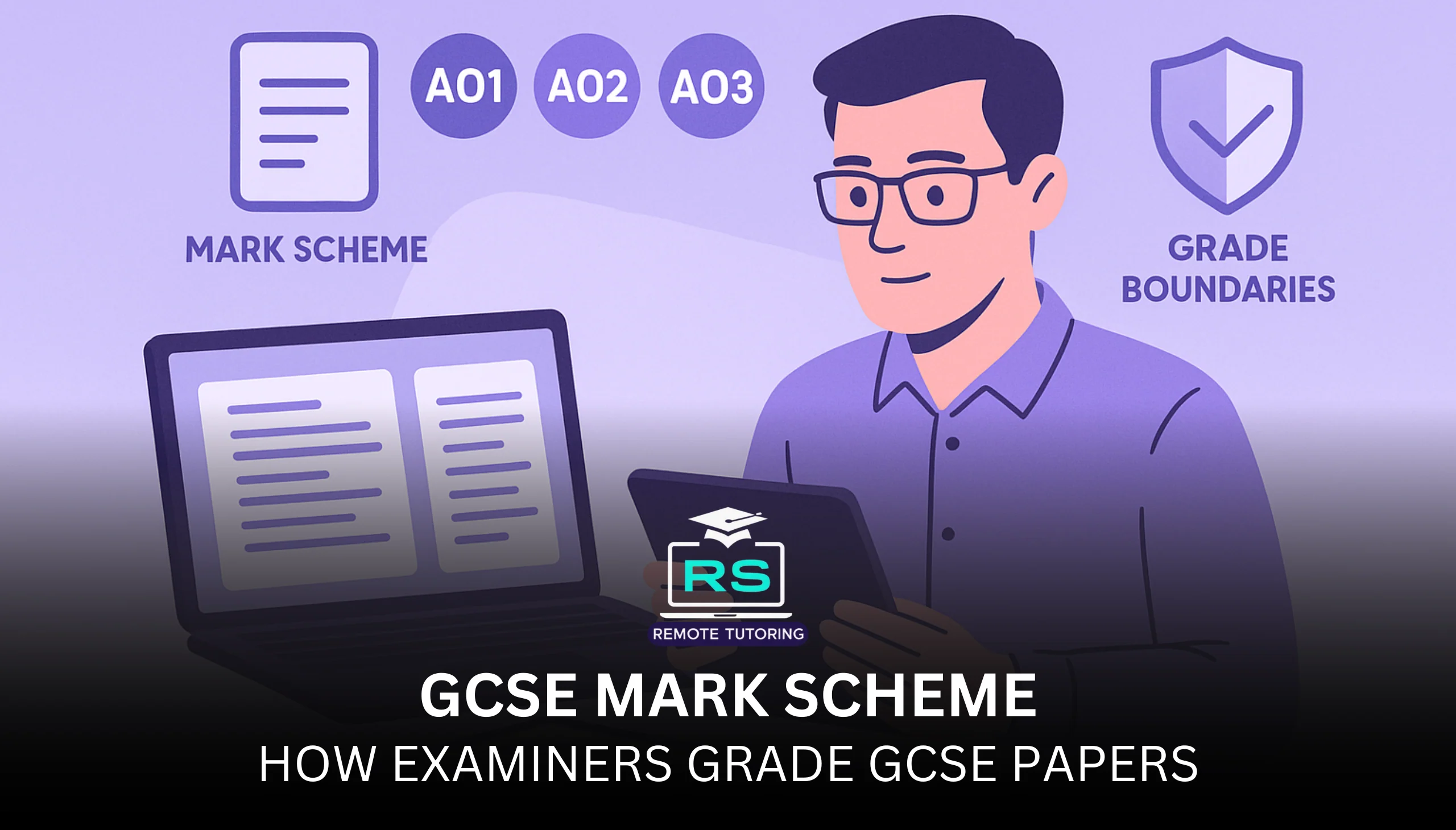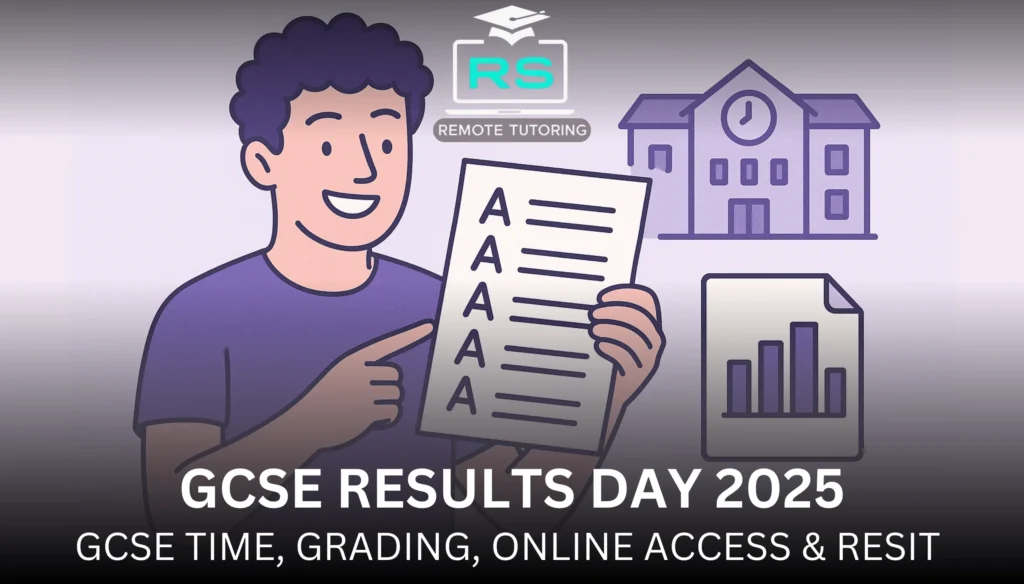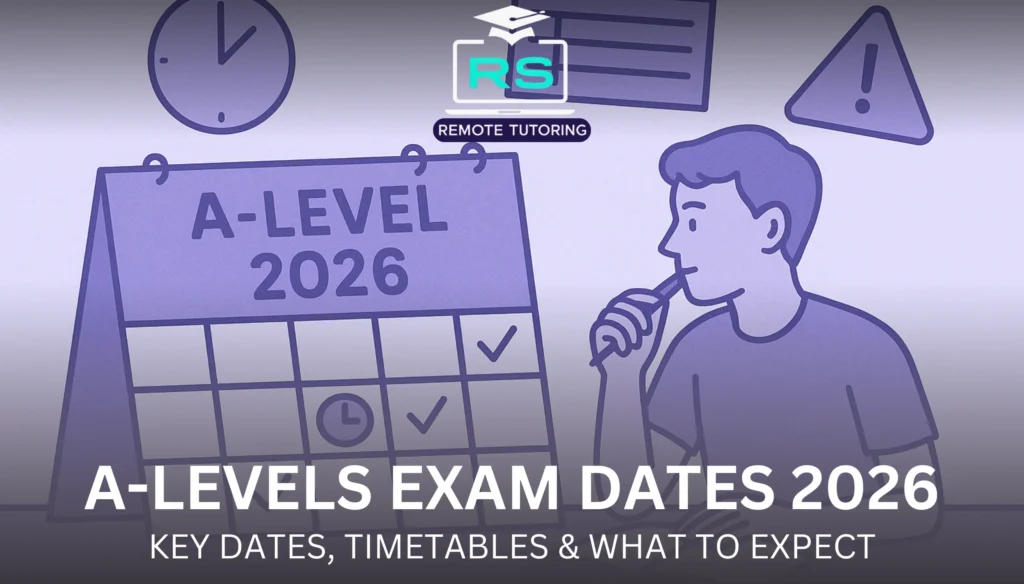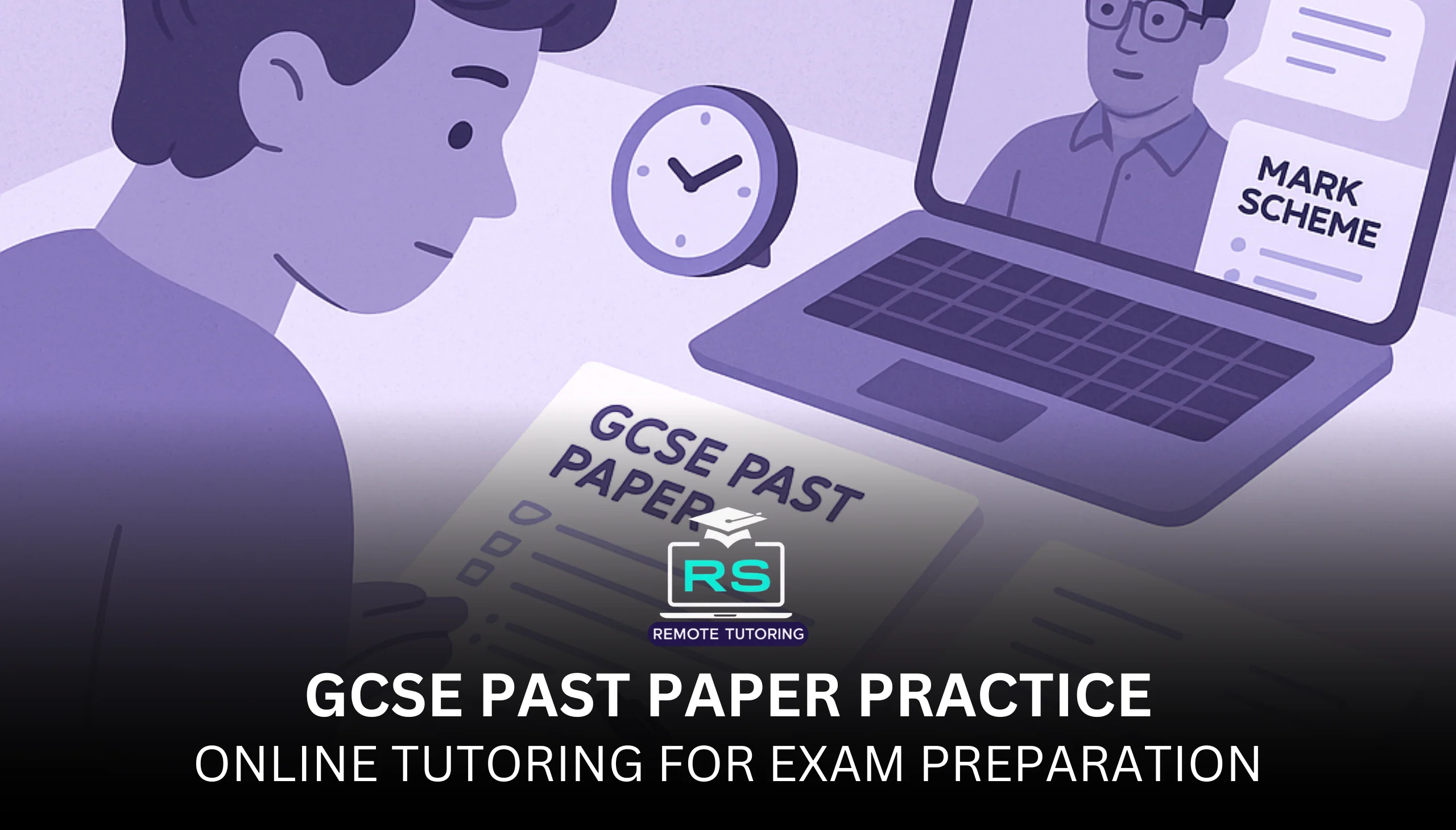Facing GCSEs can feel like walking into a maze without a map. Students spend months, or even years, learning content, practicing questions and trying to master GCSE exam technique to get their desired result. Then, on results day, they receive a single letter or number that sums up all their efforts. Understandably, we know a lot of students and parents ask us: how is that grade decided?
What happens after the exam is over, and how do examiners turn handwritten answers into reliable grades? In this guide, we cover the GCSE marking process and explain how mark schemes, examiner training and grade boundaries work together to make fair grading and consistent results. Along the way you’ll find insights from our experienced tutors and students who have seen the process from both sides.
Jump To Section
What Is a Mark Scheme of GCSE?
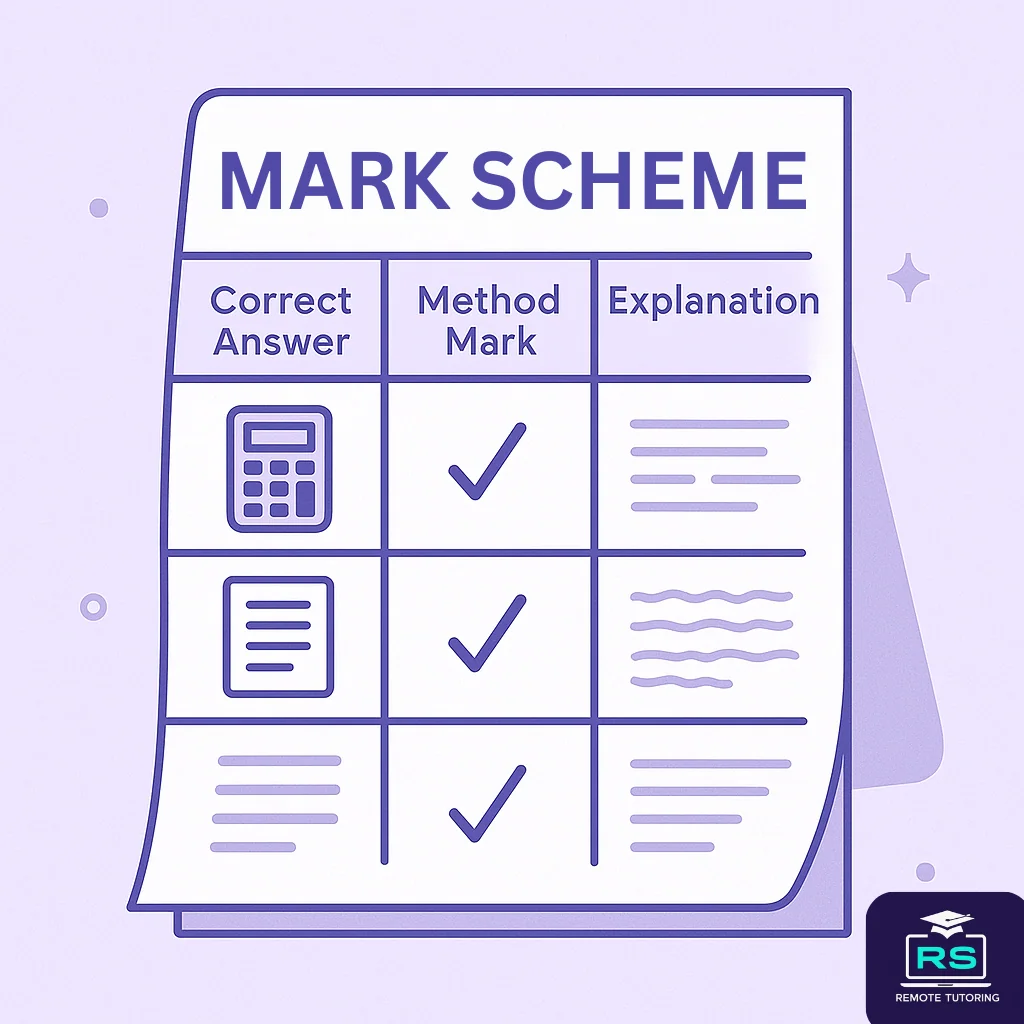
A mark scheme is a set of instructions that tells examiners how to award marks for each question. It does not just list the correct answer; it sets out the criteria required to achieve each level of response. For example, a mark scheme might specify that one mark is awarded for a correct calculation and another mark for clearly showing the method. In essay‑based subjects, the mark scheme describes the quality of content, analysis and structure needed for different mark bands.
Mark schemes are written by subject experts when they set the exam paper and are updated each year to reflect changes in the specification. Every GCSE subject has its own mark scheme, tailored to the knowledge and skills required by the syllabus. Once marking begins, examiners use the mark scheme as their reference to ensure that every student is judged by the same standards. Grade boundaries are then applied to convert raw marks into grades, a process we’ll explore later.
Why Understanding Mark Schemes Helps Students

Knowing how marks are awarded helps you focus your revision. When you review past exam papers using the mark scheme, you can see where you gained marks and where you lost them. This allows you to target specific weaknesses instead of re‑reading notes endlessly. Understanding the mark scheme also shows you how examiners expect answers to be structured. For essays, the scheme often highlights assessment objectives such as content, organisation and communication, with descriptors for each level. By aligning your answers with these descriptors, you increase your chances of achieving higher marks.
Assessment Objectives (AOs)
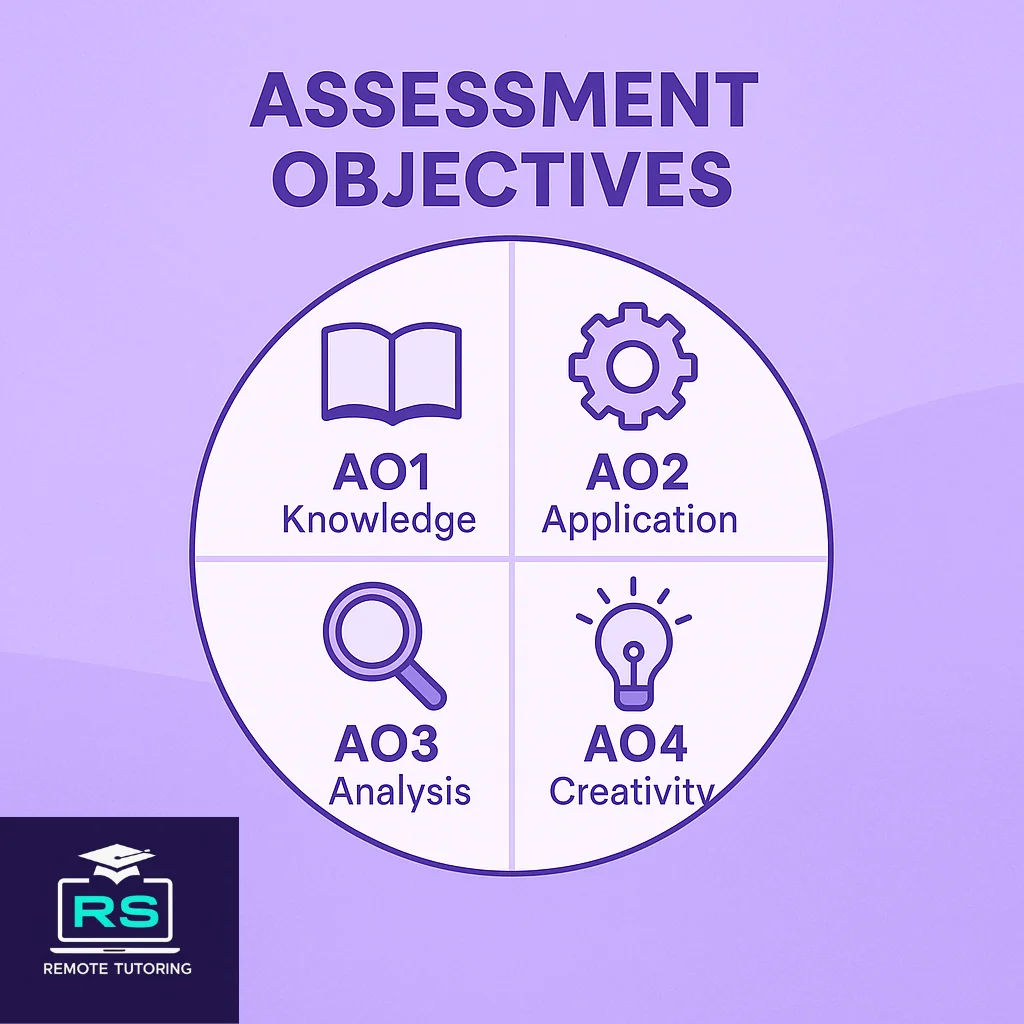
Every mark scheme is built around assessment objectives. These objectives describe what skills the exam is measuring. For example, the Edumentors guide lists four common AOs:
- AO1: Knowledge and understanding: Recalling and explaining key concepts and vocabulary.
- AO2: Application: Applying knowledge and understanding to solve problems or answer questions.
- AO3: Analysis and evaluation: Analysing information and evidence, making judgments and drawing conclusions.
- AO4: Synthesis and creativity: Creating new ideas or solutions, such as writing creatively or forming new arguments.
Different subjects emphasise different AOs. In the English language, reading and analysing texts (AO1 and AO2) may carry more weight, while in maths, using standard techniques and reasoning (AO1 and AO2) dominate. Even exam boards weigh the objectives differently; Edexcel may give equal weighting to knowledge and application while OCR weights application more heavily. Knowing these variations helps you tailor your revision to the demands of your subject and board.
How Are GCSE Papers Marked?
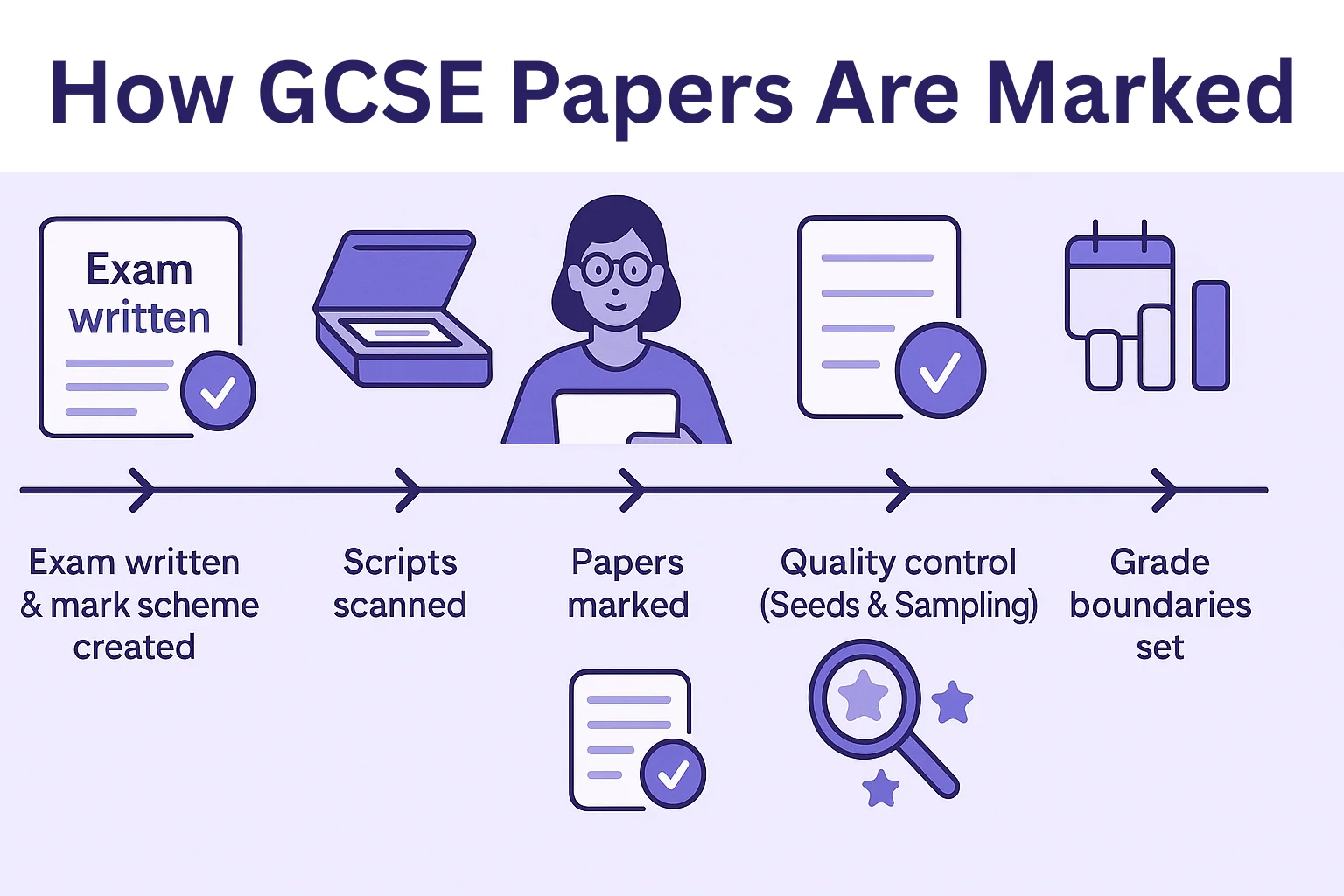
Pre‑Marking: Setting Papers and Mark Schemes
Exam papers are designed by subject experts up to two years before the exam date. Alongside the paper, they create a mark scheme that outlines how marks should be awarded. The paper and mark scheme are reviewed and adjusted to ensure that questions are valid, fair and measure the intended skills. Once the specification is finalised, it is submitted to the regulator (Ofqual) for accreditation.
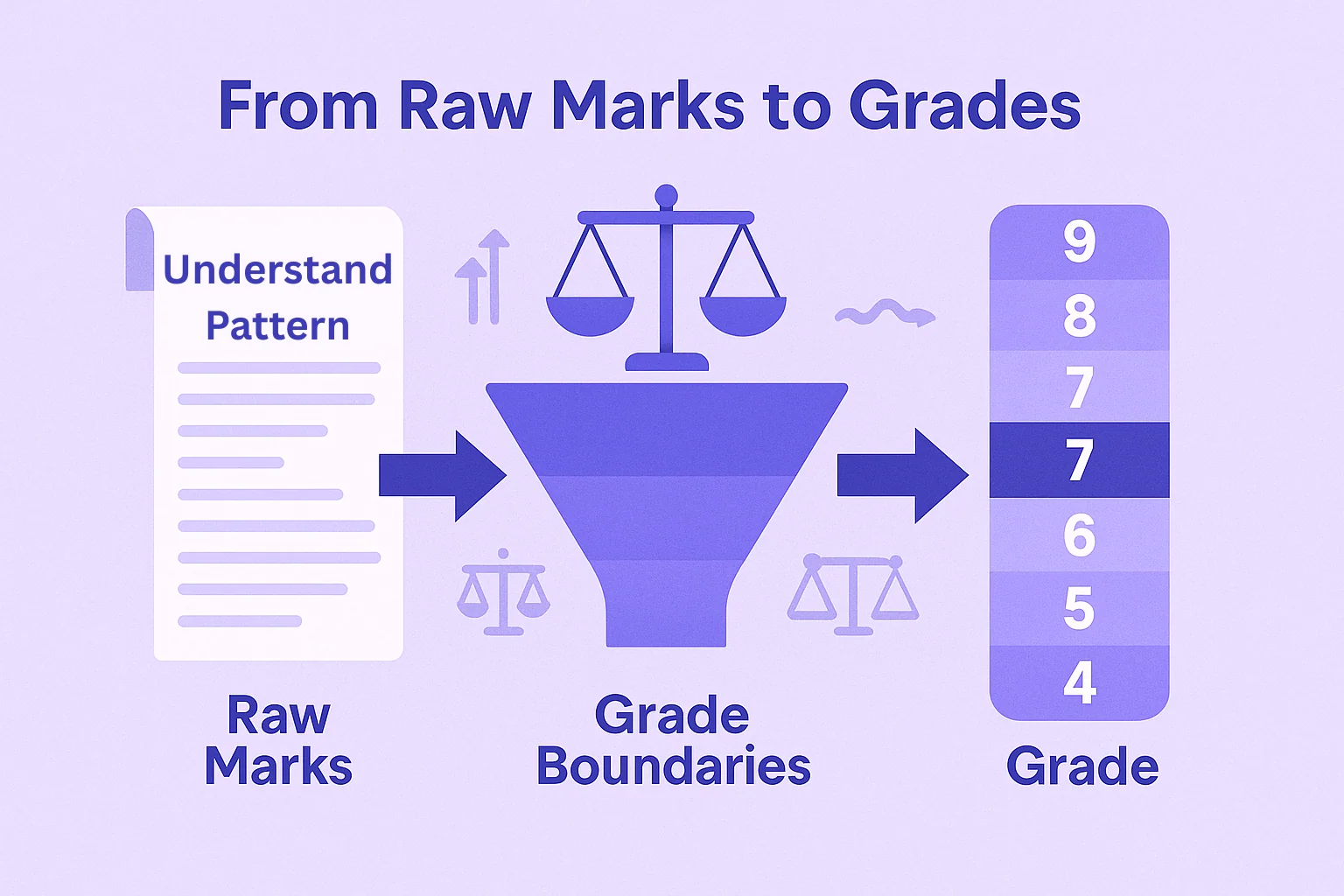
Step 1: Collecting Scripts
After students sit their exams in May and June, their answer booklets (often called scripts) are sent to the exam board. Increasingly, scripts are scanned so examiners can mark them on screen. In some cases the physical scripts are sent to a named examiner for marking.
Step 2: Training and Standardisation
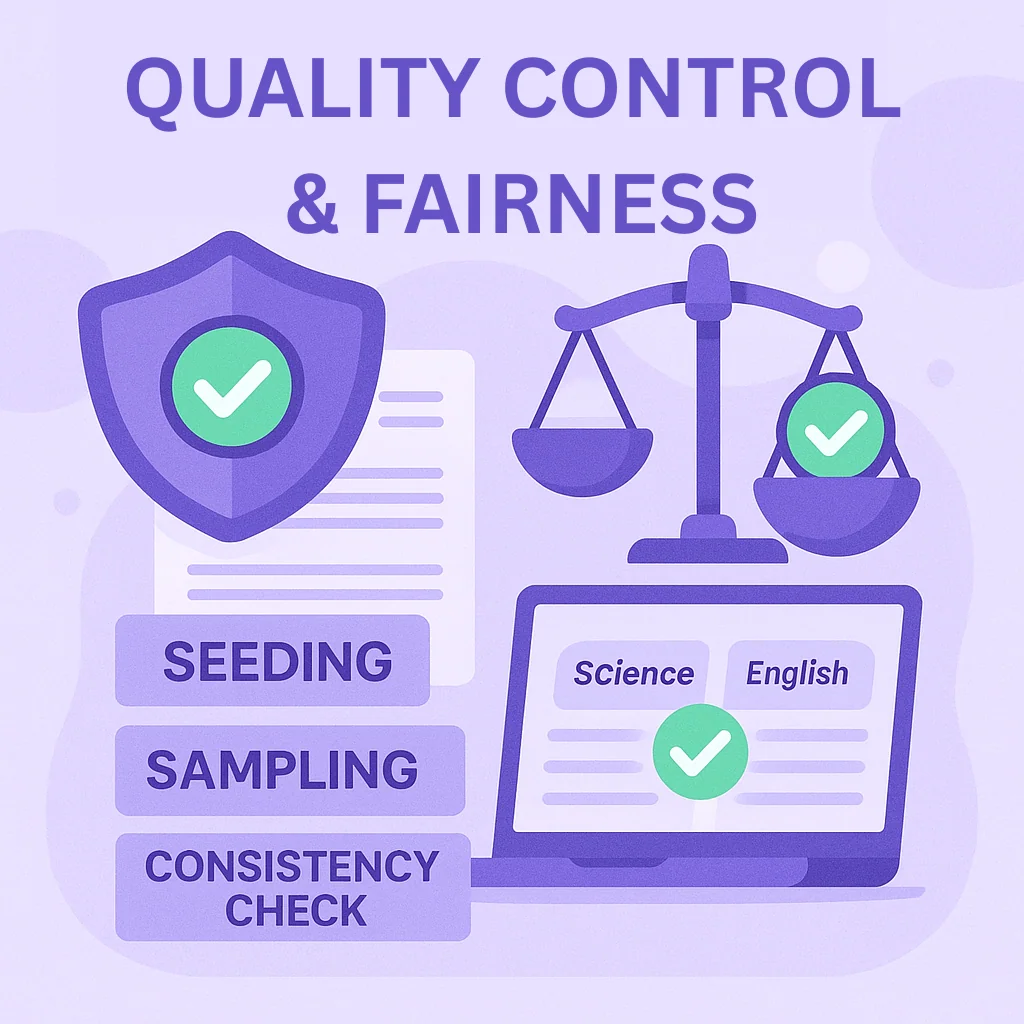
Before they can mark live scripts, examiners must be trained. They attend standardisation meetings where they learn the mark scheme and practise marking sample answers to ensure consistency. They must demonstrate that they can apply the mark scheme accurately before they are allowed to mark real scripts. Examiners are usually qualified teachers and subject specialists, though the level of experience can vary. Training ensures that even newer examiners understand what constitutes a valid response and how to award marks fairly.
Step 3: Marking – On‑Screen and On Paper
The marking window usually lasts 3-4 weeks per paper. Each examiner is assigned scripts to mark, either question by question or whole papers. For long papers, scripts may be split so multiple examiners each mark a particular question. This approach speeds up marking and helps examiners focus on a single type of response. According to Ofqual, examiners mark more than seven million scripts each summer.
During marking, exam boards carry out quality checks. Where marking is done on screen, pre‑marked answers known as seeds are inserted randomly. Examiners do not know which responses are seeds; if they fail to mark a seed correctly, their marking is paused until they receive feedback and demonstrate they can meet the required standard. When marking is done on paper, senior examiners sample each examiner’s work. If an examiner’s marking is not consistent, their scripts are reassigned to another examiner.
Step 4: Awarding Grade Boundaries
Once all papers are marked, exam boards convene awarding committees to set grade boundaries. The committee is chaired by a senior examiner and includes chief examiners, principal examiners, moderators and technical experts. The process aims to ensure that results are comparable across years and boards. Committees consider:
- Scripts from the current and previous year near the proposed grade boundaries, to maintain the same standard.
- Statistical evidence, such as the performance of the cohort in previous tests (e.g. Key Stage 2 assessments).
- Reports from senior examiners about how the exam questions worked.
- Descriptions of the performance expected at key grades.
These data help committees decide the minimum mark required for each grade. If the exam was slightly more difficult than in previous years, grade boundaries may be lower; if it was easier, boundaries may rise. Exam boards must then provide evidence to Ofqual to justify their decisions. Ofqual can accept or challenge the proposed boundaries. This ensures that grades are fair and consistent across exam boards and years.
Who Marks GCSE Papers?

Examiners are typically teachers or retired teachers with expertise in their subject. They may be early career teachers or seasoned educators. For popular subjects like maths and science, boards recruit thousands of examiners; for niche subjects, they may draw on a smaller pool. Some myths suggest that non‑specialists mark GCSEs, but examiners must demonstrate subject knowledge and undergo training. In essay subjects with obscure texts, examiners may not have taught the specific text, but the mark scheme guides them on acceptable responses and ensures fairness.
How Long Does Marking Take?
Marking usually starts shortly after the exam period and lasts around three to four weeks per paper. Large exam boards like AQA mark millions of scripts. Examiners often mark after school hours and at weekends. They are allocated a certain number of scripts and a deadline to complete them. For example, one examiner on Reddit explained that marking his allocation required about two hours each evening over the marking window and more time at weekends. This workload varies by subject and the length of the paper.
How Are Scripts Allocated?
To improve consistency, scripts are often broken down by question and distributed to many examiners. This means that one examiner might mark all Question 4(a) responses, while another marks Question 4(b). On shorter papers or subjects with fewer candidates, a single examiner might mark whole papers. Splitting papers by question reduces bias and ensures that no examiner’s judgement affects an entire paper.
Quality Control: Seeds and Sampling
Quality control is an essential part of the marking process. On-screen marking allows exam boards to insert seed responses, answers that senior examiners have already marked and agreed on. When an examiner marks a seed, the system compares their mark to the agreed mark. If they deviate, the examiner is flagged and given feedback. They must correct their marking before continuing. In paper marking, senior examiners sample an examiner’s work; if they find inconsistencies, the examiner is removed from marking.
Grade Boundaries and Grade Scale

Raw Marks vs Grades
After marking, each student has a raw mark, the total number of marks awarded across all papers. Grade boundaries convert raw marks into grades (for example, 9–1 in England). Because exam difficulty can vary slightly each year, the raw marks needed for each grade also change. This ensures that a grade 4 (standard pass) in one year represents the same standard as a grade 4 in another year.
Why Do Grade Boundaries Change?
Exam boards aim for consistency over time. However, papers are set by humans and some may be more difficult than others. Awarding committees adjust grade boundaries to account for these differences. They consider statistical evidence of the cohort’s prior attainment and the performance of scripts around the proposed boundaries. For example, if the paper was harder than expected, the grade boundaries may be lowered so that the distribution of grades matches predictions. If the paper was easier, boundaries may be raised.
How Students Can Use Mark Schemes to Improve Their Grades
Mark schemes aren’t just for examiners, they are powerful revision tools. Here are ways to use them effectively:
Review Your Answers Against the Mark Scheme
When you practise past papers, mark your answers using the official mark scheme. Highlight where you lost marks and identify why. Was it a calculation error? Did you forget a key term? Did you answer the wrong type of question? Keep a record of these mistakes so you can prioritise them in revision. Our maths tutor Mark Robinson notes, “Students often lose marks for not showing their working. In maths papers, method marks are crucial. Even if you get the final answer wrong, clear working can earn partial credit.”
Learn Command Words and Key Phrases
Mark schemes show how examiners interpret command words like describe, explain, evaluate and compare. They also include subject‑specific vocabulary that earns marks. For science, using correct units and terms can make the difference between full marks and losing easy points. English tutor Emily Johnson tells her students to build a bank of sophisticated phrases for literary analysis and practise integrating quotations smoothly, because the mark scheme rewards precise language and well-structured arguments.
Practise Under Timed Conditions
Complete practice papers under exam conditions and mark them afterwards. Time management is a skill that needs practice; you’ll learn how long to spend on each question and when to move. Our science tutor Sarah Ahmed emphasises that “students who leave questions blank because they run out of time miss out on easy marks. Past papers help you pace yourself so you can attempt every question.”
Use Examiner Reports
Examiner reports provide summaries of how students performed in each exam series. They highlight common mistakes, misconceptions and areas where students gained easy marks. Reading these reports can help you avoid the same pitfalls. They also give insight into how examiners interpret ambiguous answers and what makes top‑level responses stand out. Our tutors often integrate examiner report excerpts into revision sessions to show students concrete examples of good and poor answers.
Don’t Rely Exclusively on the Mark Scheme
While mark schemes are valuable, they shouldn’t be the only resource you use. They are designed to assess specific exam questions, not to teach the underlying content. Make sure you understand the material thoroughly by using textbooks, revision guides and online resources. Once you have a solid grasp of the content, use mark schemes to refine exam technique and check your answers.
Common Myths and Misunderstandings About GCSE Marking
“Non‑specialists mark the exams.”
Examiners are recruited for their subject expertise. Most are qualified teachers with experience teaching the subject, although the level of experience varies. They undergo training and must demonstrate they can apply the mark scheme accurately before marking live scripts. In subjects with less popular texts, examiners might not have taught that text, but the mark scheme guides them on what to credit.
“My paper will be marked by one examiner who judges my entire script.”
Many exam boards split scripts by question, especially for subjects with large entry numbers. This means different parts of your paper may be marked by different examiners. Splitting ensures speed and consistency. Quality control checks catch inconsistencies and reseed examiners who mark incorrectly.
“Memorising the mark scheme is enough to get a top grade.”
Mark schemes show what examiners credit, but they change from year to year and across boards. The best use of a mark scheme is to learn how to structure answers, not to memorise model answers. Focus on understanding the content and practising application.
“Grade boundaries are fixed and secret.”
Grade boundaries are set after marking and vary each year based on exam difficulty. Exam boards publish grade boundaries when GCSE Exam & results are released, so they are not secret. Understanding that boundaries change can help you interpret your raw marks sensibly.
“Marking errors are common.”
While no system is perfect, multiple checks, training, seeding, sampling and statistical evidence – ensure that marking is consistent and fair. If you believe your mark is wrong, you can request a review of marking. In most cases, the original mark is upheld, indicating that the system is robust.
Student and Tutor Perspectives
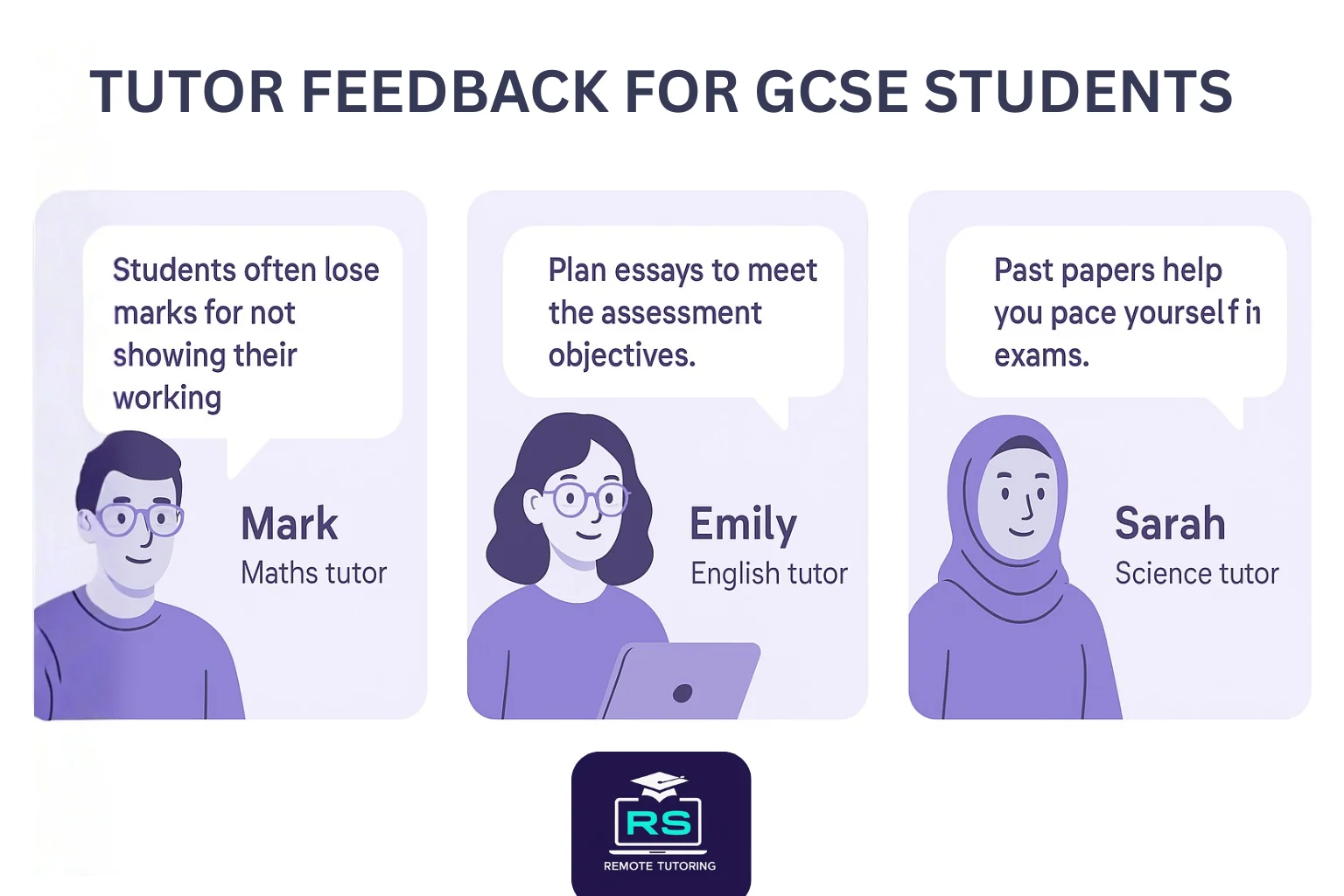
Our tutors see first‑hand how understanding mark schemes transforms revision. Mark Robinson, a maths specialist, recalls a student who repeatedly lost marks for missing units and failing to show working. After spending time analysing the mark scheme and practising under timed conditions, the student’s marks improved by two grades. Emily Johnson tells a similar story about an English language student who wrote beautifully but didn’t answer the question. Using past paper mark schemes, she learned how to plan essays to meet the assessment objectives, boosting her grade from a 6 to a 9. Sarah Ahmed reports that students who practise science questions with a mark scheme learn to use key vocabulary and earn marks for describing experimental methods correctly.
Students themselves often find the process enlightening. One Year 11 student, Alex, said that marking his own past papers using the official scheme highlighted patterns in his mistakes. “I realised I always lost marks on probability questions because I didn’t simplify fractions,” he says. “After correcting that, my marks in maths jumped by nearly 20 per cent.”
What Parents Need to Know
Understanding how exams are marked can reassure parents and help them support their child effectively:
- Fairness is built into the system. Examiners are trained, scripts are quality‑checked and grade boundaries are set using statistical evidence.. Your child’s grade reflects their performance relative to national standards, not the whim of an examiner.
- Grade boundaries change. Don’t be alarmed if raw marks seem low; what matters is the grade boundary that year.
- Support your child with mark scheme practice. Encourage them to complete past papers, mark them using official schemes and learn from their mistakes. Provide a quiet space and help them manage their time.
- Don’t obsess over marks. Praise effort and improvement. Use mock exam results as diagnostics, not final judgments. If concerns arise, speak to teachers or consider seeking extra support from qualified tutors.
Frequently Asked Questions
Are GCSE examiners paid?
Yes. Examiners are paid per script or per question. The rate varies by subject and exam board. Marking is usually done alongside full‑time teaching.
How long after the GCSE exams are results released?
GCSE results day is typically in August. This gives exam boards time to mark scripts, set grade boundaries and finalise results.
Can I appeal my GCSE grade?
You can request a review of marking if you believe there has been an error. A second examiner will re‑mark your script. Grades can go up, stay the same or go down. Appeals must be submitted through your school or college.
What is an examiner’s report in GCSE Result?
Examiner reports are published after each exam series and summarise how students performed. They highlight common mistakes, areas where students did well and give advice for future candidates.
What happens to my paper if I type my answers?
Typed scripts are also scanned and uploaded. Examiners mark them on screen in the same way as handwritten scripts. Your answers are split by question and sent to the appropriate examiner.
Conclusion
The GCSE grading process may seem mysterious, but it is built on clear principles of fairness and consistency. Mark schemes provide the blueprint for awarding marks, examiners are trained and monitored to apply those schemes correctly, and grade boundaries ensure that grades are comparable across years. As a student, understanding how your work will be marked can transform your revision and boost your confidence. Use mark schemes to analyse your strengths and weaknesses, learn command words, practise under timed conditions and read examiner reports. As a parent, trust in the system and support your child by providing structure and encouragement.
If you want expert guidance tailored to your needs, our tutors at RS Remote Tutoring are here to help. We specialise in one‑to‑one online sessions that focus on exam technique, mark scheme comprehension and subject mastery. Book a free consultation today to see how we can support your journey to GCSE success.

Raja specializes in Physics and Maths, with over 5 years of experience. He offers KS2, KS3, and GCSE Science and Maths lessons. He graduated from one of the top universities in the UK.

